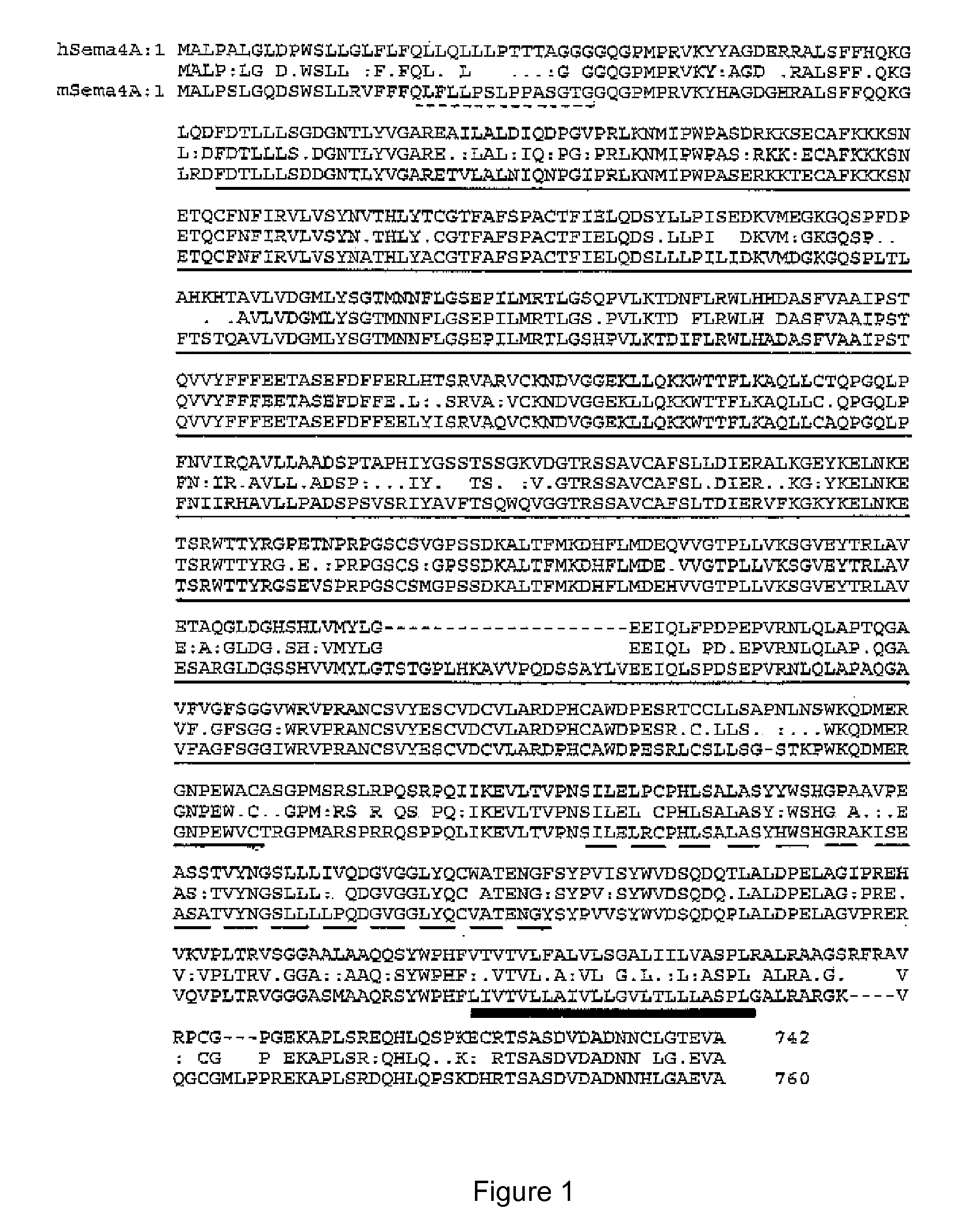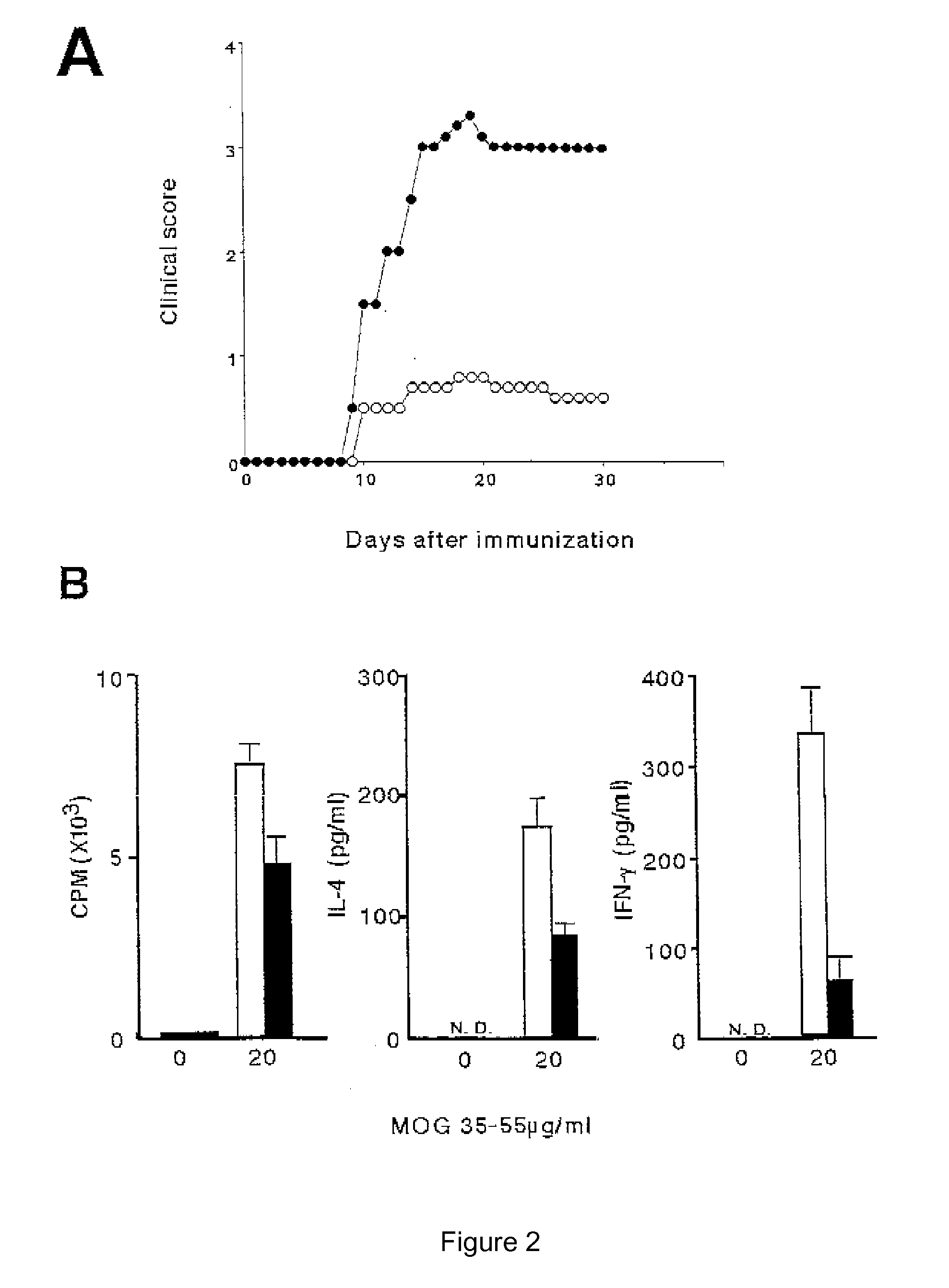Human sema4a protein antibodies and uses thereof
a protein and antibody technology, applied in the field of new costimulatory proteins, can solve the problems of not fully elucidating the costimulatory activities, the framework of costimulatory molecules which determine the qualitative and quantitative t-cell responses has not yet been fully elucidated, and the insufficient treatment of t cell function abnormalities, so as to stimulate t cell mediated immune responses
- Summary
- Abstract
- Description
- Claims
- Application Information
AI Technical Summary
Benefits of technology
Problems solved by technology
Method used
Image
Examples
example 1
Isolation of Mouse and Human Sema4A
[0068] In an effort to understand semaphorins expressed in DCs, PCR cloning using degenerated oligonucleotide primers based on conserved motifs among members of the semaphorin family has been performed. Thereby, a cDNA fragment of Sema4A which has been classified into the class IV of the semaphorin family has been identified. Sema4A was originally identified as semB of which expression has been observed in mouse embryos, although no information on its function has been reported. Since the human homologue of Sema4A was not identified, the database of National Center for Biotechnology Information (NCBI) was searched with the nucleotide sequence of mouse Sema4A. Based on the resulting incomplete nucleotide sequence of human Sema4A, a full-length of complementary cDNA from a human brain cDNA library was isolated and its complete nucleotide sequence was determined. As shown in FIG. 1, a 78% identity in the amino acid sequence between the human and mous...
example 2
Expression of Sema4A
[0069] Although the expression of mouse Sema4A during embryonic development has been reported, its expression profiles in the adult tissues have not been reported. To exclude the possible cross hybridization among the semaphorin family in the case of northern blot analysis, RT-PCR for analysis of Sema4A-expression using Clontech, BD Biosciences, Palo Alto, Calif.'s mouse multiple tissue cDNA panels was performed. The results were as follows: Sema4A was expressed in a broad range of tissues with prominent levels in the brain, spleen, lung, kidney and testis. In addition, the expression of Sema4A was not detectable by embryo day 7 but it became detectable and gradually increased during embryonic development, of which embryonic expression profiles are consistent with those reported previously.
[0070] To investigate the functions and expression of Sema4A in the immune system, recombinant soluble mouse Sema4A protein consisting of the putative extracellular region of...
example 3
Involvement of Sema4A in T Cell Activation
[0072] To test whether Sema4A has an effect on T cell activation, CD4+ T cells were stimulated with immobilized anti-CD3 plus anti-CD28 in the presence or absence of Sema4A-Fc. As a result, Sema4A-Fc enhanced anti-CD3 induced T cell proliferation and IL-2 production.
[0073] Next it was examined whether Sema4A promotes the differentiation of T cells into Th1-like or Th2-like effector populations under the respective culture conditions. Naive T cells were cultured with anti-CD3 plus anti-CD28 in the presence of IL-12 plus anti-IL-4 (Th1 conditions) or IL-4 (Th2 conditions) for 6 days, and the resulting cells were re-stimulated with anti-CD3 plus anti-CD28 for 48 hr. The production of IFN-γ or IL-4 was measured by ELISA. In the presence of Sema4A-Fc, the induction of either IFN-γ or IL-4 producing cells was significantly enhanced compared to that in the absence of Sema4A-Fc. However, Sema4A-Fc did not have any effects on Th1-like or Th2-like e...
PUM
| Property | Measurement | Unit |
|---|---|---|
| concentration | aaaaa | aaaaa |
| concentration | aaaaa | aaaaa |
| density | aaaaa | aaaaa |
Abstract
Description
Claims
Application Information
 Login to View More
Login to View More - R&D
- Intellectual Property
- Life Sciences
- Materials
- Tech Scout
- Unparalleled Data Quality
- Higher Quality Content
- 60% Fewer Hallucinations
Browse by: Latest US Patents, China's latest patents, Technical Efficacy Thesaurus, Application Domain, Technology Topic, Popular Technical Reports.
© 2025 PatSnap. All rights reserved.Legal|Privacy policy|Modern Slavery Act Transparency Statement|Sitemap|About US| Contact US: help@patsnap.com


